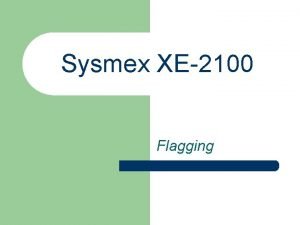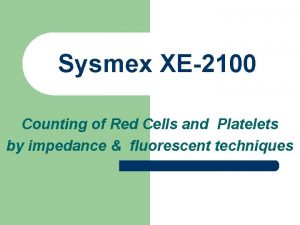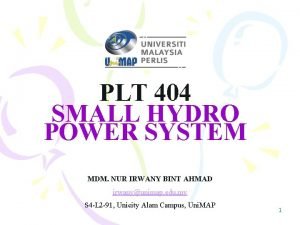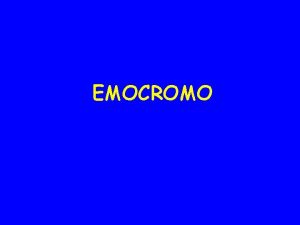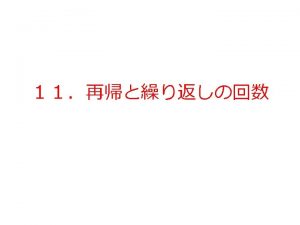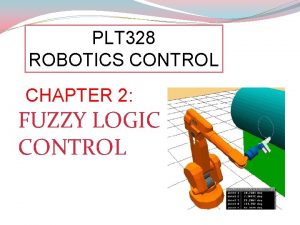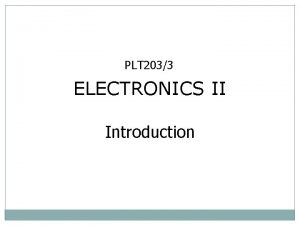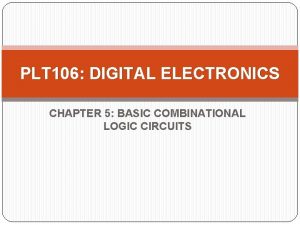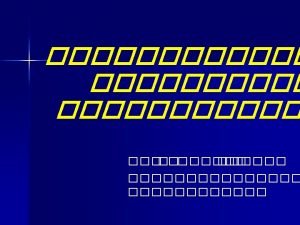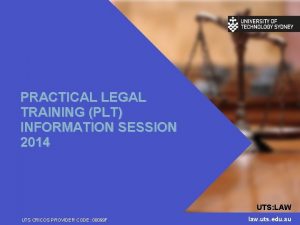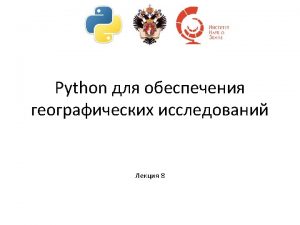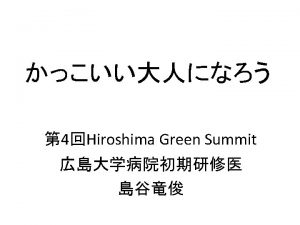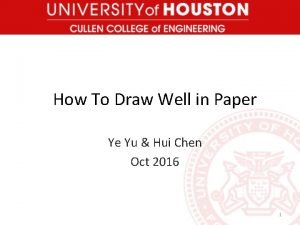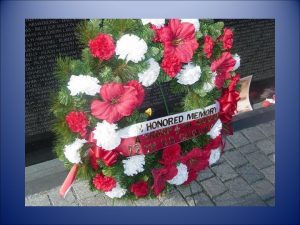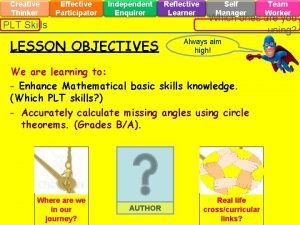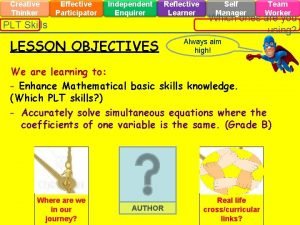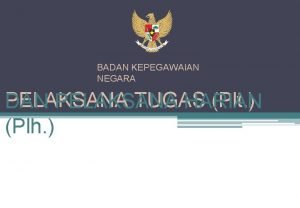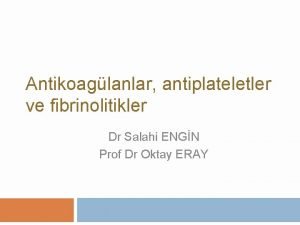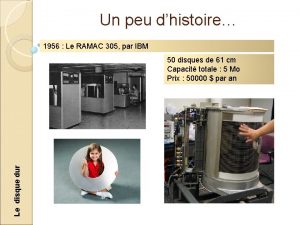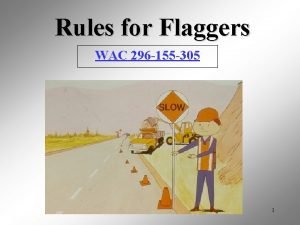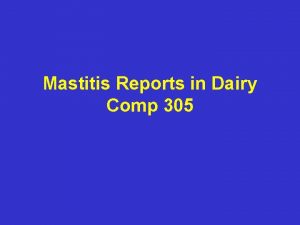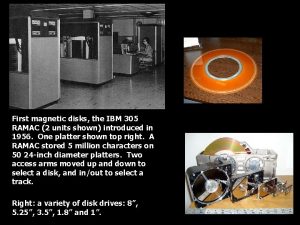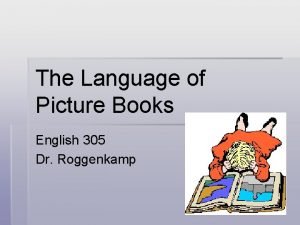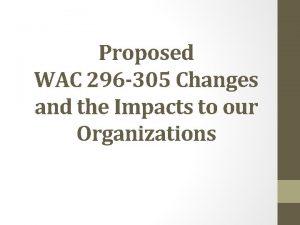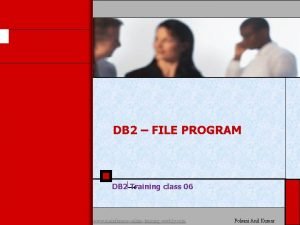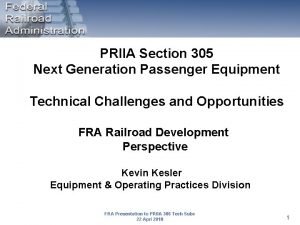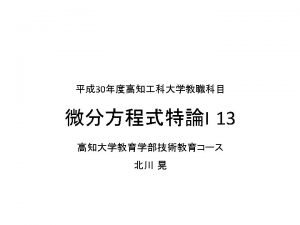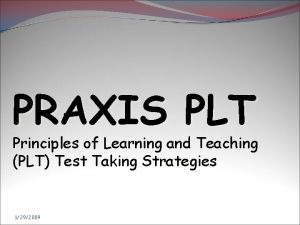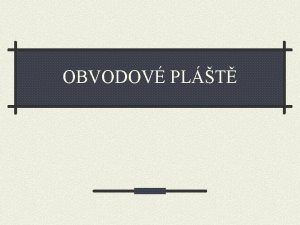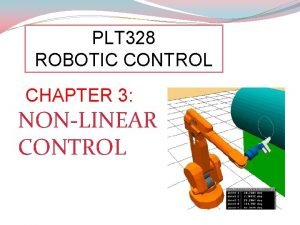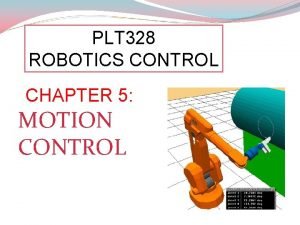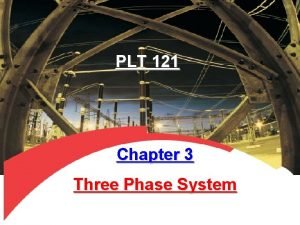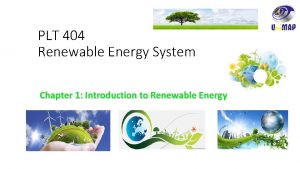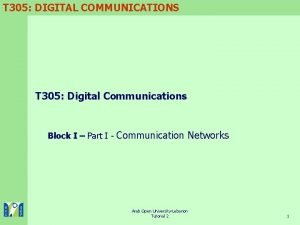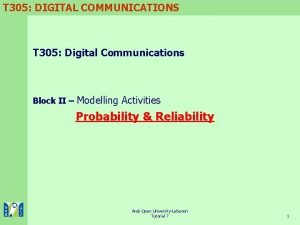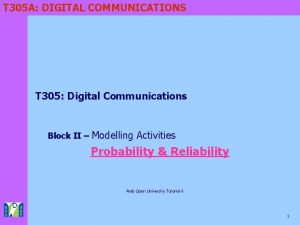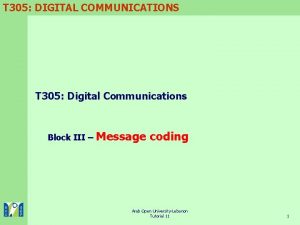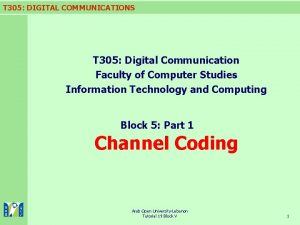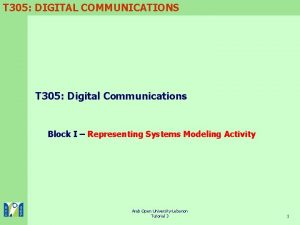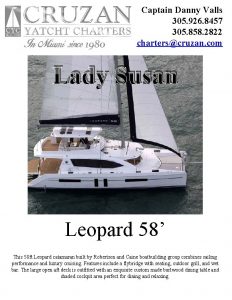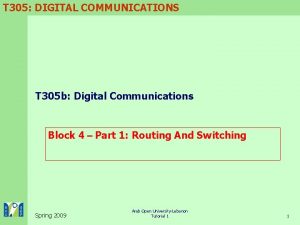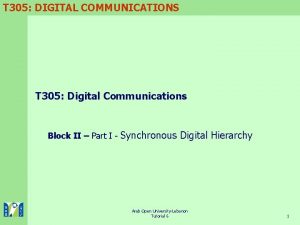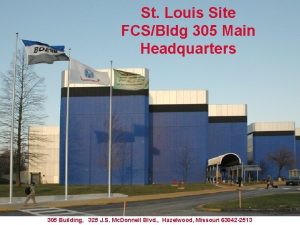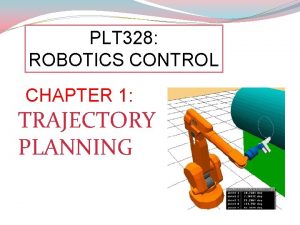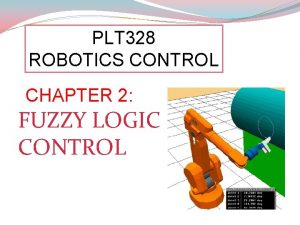CHAPTER 1 Introduction to Control System PLT 305
































- Slides: 32

CHAPTER 1 Introduction to Control System PLT 305 : CONTROL SYSTEMS TECHNOLOGY 1

Objectives of Chapter ý Basic terminologies. ý Open-loop and closed-loop. ý Block diagrams. ý Control structure. ý Advantages and Disadvantages of closed-loop. 2

1. 1 Introduction Control – The process of causing system variable to conform to some desired value System – A combination of components that act together and perform a certain objective Process Input and Output ý Input = Stimulus ý Output = Response 3

Cont’d… Advantages of control systems; ý Can move large objects with precision; for example (i) elevator, (ii) radar antenna to pickup strong radio signal and (iii) robot to operate in the dangerous environment. ý To provide convenience by changing the form of the input 4

Cont’d… n n Control is a process of causing a system variable such as temperature or position to conform to some desired value or trajectory, called reference value or trajectory. For example, driving a car implies controlling the vehicle to follow the desired path to arrive safely at a planned destination. i. ii. If you are driving the car yourself, you are performing manual control of the car. If you use design a machine, or use a computer to do it, then you have built an automatic control system. 5

1. 2 Basic Terminologies Control Variable - Quantity or condition that is measured and controlled Manipulated variable - Quantity or condition that is varied by the controller to affect the value of the controlled variable Plants - A piece of equipment Processes – Continuing operation that consists of the series of controlled actions Disturbances – The unwanted signal that may sway the output Feedback control – An operation that tends to reduce the difference between the output system and reference inputs 6

1. 3 Categories of Control System Component or process to be controlled can be represented by a block diagram. Control systems can be classified into two categories: i. Open-loop control system ii. Closed-loop feedback control system 7

1. 3. 1 Open Loop System. Desired Output Response Controller Actuator Output Process ý An open-loop control system utilizes an actuating device to control the process without using feedback ý Uses a controller and actuator to obtain the desired response ý The open loop system cannot compensate for any disturbance that add to the system. ý Example; bread toaster, washing machine 8

1. 3. 2 Close-Loop System. ý A close-loop system uses a measurement of the output and feedback of the output signal to compare it with the desired output or reference ý The close-loop system can overcome the problem of the open loop system in term of sensitivity to disturbance and inability to correct the disturbance. ý Example; Temperature control system Desired Output Response Comparison Controller Process Output Measurement 9

1. 4 System Response ý Ability of system to achieve desired result is measured in terms of system response: comparison of output versus input. ý Example: Elevator When pressed fourth-floor from first floor, the elevator rises to the fourth floor with a speed and floor-leveling accuracy design for passenger comfort. ý Transient response. ý Steady State Response. ý Steady State Error. 10

1. 5 Advantages and Disadvantages Feedback system Open-loop No feedback system is used Close-loop - Feedback system makes the system insensitive to disturbance Stability Easier to build More complex Time consuming Cost Faster Slower Cheaper More expensive Application Simple application - House Complex application - Industry 11

Examples of Modern Control System n n n a. Transportation b. Temperature Control c. Process Industry d. Manufacturing Industry e. Homes 12

a. Transportation Car and Driver Objective: To control direction and speed of car Outputs: Actual direction and speed of car Control inputs: Road markings and speed signs Disturbances: Road surface and grade, wind, obstacles Possible subsystems: The car alone, power steering system, breaking system 13

Transportation cont. . n Functional block diagram: Desired course of travel + Error - Driver Steering Mechanism Automobile Measurement, visual and tactile n Time response: 14 Actual course of travel

Transportation cont. . n Consider using a radar to measure distance and velocity to autonomously maintain distance between vehicles. n Automotive: Engine regulation, active suspension, anti-lock breaking system (ABS) Steering of missiles, planes, aircraft and ships at sear. 15 n

b. Temperature Control Schematic diagram of temperature control of an electric furnace. The temperature in the electric furnace is measured by a thermometer, which is analog device. The analog temperature is converted to a digital temperature by an A/D converter. The digital temperature is fed to a controller through an interface. This digital temperature is compared with the programmed input temperature, and if there is any error , the controller sends out a signal 16 to the heater, through an interface, amplifier and relay to bring the furnace temperature to a desired value.

c. Process Industry Control used to regulate level, pressure and pressure of refinery vessel. Coordinated control system for a boilergenerator. For steel rolling mills, the position of rolls is controlled by the thickness of the steel coming off the finishing line. 17

d. Manufacturing Industry n Consider a three-axis control system for inspecting individual semiconducting wafers with a highly sensitive camera 18

e. Homes i. CD Players n ii. The position of the laser spot in relation to the microscopic pits in a CD is controlled. Air-Conditioning System n Uses thermostat and controls room temperature. 19

Design Examples n Turntable Speed Control 20

Turntable Speed Control n Application: CD player, computer disk drive Requirement: Constant speed of rotation Open loop control system: n Block diagram representation: n n 21

Turntable Speed Control cont. . n Closed-loop control system: n Block diagram representation: 22

Sequential Design Example n Disk Drive Read System 23

Disk Drive Read System Goal of the system: Position the reader head in order to read data stored on a track. Variables to control: Position of the reader head 24

Disk Drive Read System n n Specification: i. Speed of disk: 1800 rpm to 7200 rpm ii. Distance head-disk: Less than 100 nm iii. Position accuracy: 1 µm iv. Move the head from track ‘a’ to track ‘b’ within 50 ms System Configuration: 25

Response Characteristics n Transient response: n n Steady-state response: n n Gradual change of output from initial to the desired condition Approximation to the desired response For example, consider an elevator rising from ground to the 4 th floor. 26

Control System Classification Missile Launcher System 27

Control System Classification Missile Launcher System 28

Examples: Mechatronic System a. Hybrid Fuel Vehicles n b. Wind Power n 29

a. Hybrid Fuel Vehicles 30

b. Wind Power 31

Control System Design Process 1. Determine a physical system and specifications from the requirements 2. Draw a functional block diagram 3. Transform the physical system into a schematic 4. Use the schematic to obtain a block diagram, signal-flow diagram or statespace representation 5. If multiple blocks, reduce the block diagram to a single block or close-loop system 6. Analyze, design and test to see that requirements and specifications are met 32
 Plt abn distribution meaning
Plt abn distribution meaning Sysmex xe2100
Sysmex xe2100 Mdm hydra
Mdm hydra Istogramma rbc
Istogramma rbc Plt scheme
Plt scheme Fuzzification
Fuzzification Plt electronics
Plt electronics Plt 106
Plt 106 What is considered high voltage
What is considered high voltage Fcps my plt
Fcps my plt Plt in cbc
Plt in cbc Uts plt
Uts plt Plt morphology
Plt morphology คืออะไร
คืออะไร Import numpy as np import matplotlib.pyplot as plt
Import numpy as np import matplotlib.pyplot as plt Gdlp anu
Gdlp anu Labo
Labo Plt.triplot
Plt.triplot Billy b and plt
Billy b and plt Plt skills
Plt skills Plt skills
Plt skills Kewenangan plt dan plh dalam aspek keuangan
Kewenangan plt dan plh dalam aspek keuangan Antiplateletler
Antiplateletler Disque dur ibm 1956
Disque dur ibm 1956 Partes de un cordon de soldadura
Partes de un cordon de soldadura Wac 296-155
Wac 296-155 Dairy comp 305
Dairy comp 305 Ramac 305
Ramac 305 Wac 296 305
Wac 296 305 English 305 book
English 305 book Wac 296.305
Wac 296.305 Sqlcode 305
Sqlcode 305 Next generation equipment committee
Next generation equipment committee
